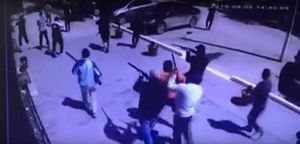There never appears to be a dearth of reports in Western media and security circles on violent extremism — or rather, the possibility of a growing threat from violent Islamic extremism — in Central Asia. Analysts called 2016 a heated year for terrorism in the region. At a London conference in April, a security analyst cited incidents in Aktobe and Almaty in Kazakhstan and an attack on the Chinese embassy in Bishkek, Kyrgyzstan, as evidence of what one report has defined as a new wave of radicalization in the region.
Speaking at an event in Kazakhstan this summer, a U.S. official stated that “Central Asia is on the U.S. radar only because of Afghanistan. This is the region’s number one problem.”
And yet, even from casual conversations with the average man in the street one can easily deduce that anything from trade, oil prices, inflation, mortgages, corruption, migration, and even traffic jams are more pressing problems in everyday life across Central Asia than the alleged menace of violent extremism. In addition, the local governments’ lack of transparency in security matters, as well as their compromised justice systems and media, should give observers reason to pause.
In August, two Foreign Policy (FP) articles charged that violent Islamic extremism is on the rise in Kazakhstan and Kyrgyzstan. The first dispatch focused on the Aktobe attack, when more than two dozen men robbed a gun shop and engaged in a series of shootouts with the Kazakh police and national guard, leaving 25 dead, including 18 attackers, and spreading panic across the country. No sooner had the shock from the attack subsided that, a month later, a lone gunman killed nine in Almaty, Kazakhstan’s largest city. A second report from the city of Osh, in southern Kyrgyzstan, argued that a combination of “ethnic strife, corruption, and poverty [could] derail the government’s efforts to come to grips with a rise in extremist activity since the start of the Syrian civil war.”
According to FP, whereas the threat in Kazakhstan is homegrown, in Kyrgyzstan it mostly emanates from the links between the local population and the raging conflicts in Iraq and Syria, where people, mostly from the country’s Uzbek minority, have traveled to fight. Still, it is striking that while the dispatches correctly refer to the local socio-political dynamics of poverty, marginalization and state violence, violent Islamic extremism is treated as the main focus, starting from the sensationalism of the quote used as a title for the Kazakhstan-focused piece: “Our future will be violent extremism.” In other words, the authorities’ claims that violent extremism is a major problem and is indeed growing are taken at face value, as is the link between violence and an ill-defined non-traditional (radical, Salafi) Islam.
Instead, a series of unrelated attacks became enough evidence to confirm the credibility of the threat in Kazakhstan, despite the many doubts surrounding the official version of events. Why, for instance, didn’t the Kazakh gunmen attack soft civilian targets? How can one reconcile the radical Islam allegation with reports that the Almaty shooter spent the night before the attack with a prostitute? Why was information contradicting the radicalization narrative – for example, that Kazakhstan’s Interior Ministry called the Almaty gunman a “petty criminal” and the country’s Prison Service denied he was “radicalized” while in detention – withheld?
Moreover, there is the unresolved question of motive. For all the talk of a “movement,” none was named and none has claimed responsibility for the attacks. As FP reports, the Aktobe gunmen lived at the bottom of the socioeconomic ladder: “… many of the other attackers share similar backgrounds as Tanatarov: living lives of poverty, working in the gray economy, and some even serving time in prison.” Similarly to Ruslan Kulekbayev, the Almaty lone shooter, they invariably targeted law enforcement officials. This is a typical strategy that the dispossessed employ to express their rage towards a state that fails to provide opportunities for personal development. Examples of small-scale violent outbreaks against local administrations or public self-immolations fill the monthly news feed of any Central Asia watcher.
Finally, figures of Central Asian foreign fighters in Iraq and Syria should be taken with a huge grain of salt. The Soufan Group referenced in the FP reports is a private consultancy founded and filled by former U.S. intelligence personnel. While its strong security slant justifies its raison d’être, in its reports Soufan referred to the lower end of figures put forward in a widely-circulated January 2015 International Crisis Group document, which argued that between 2,000 and 4,000 Central Asians had gone to fight for Islamic State in the previous three years.
Subsequently, two scholars, John Heathershaw and David W. Montgomery, found these numbers to be “no more than guesswork.” In a Chatham House report tellingly entitled The Myth of Post-Soviet Muslim Radicalization in the Central Asian Republics, the two academics asserted that “the idea that there is a general phenomenon of post-Soviet Muslim radicalization in Central Asia is best regarded as a myth,” adding that “there is very little evidence to support the idea of post-Soviet Muslim radicalization in Central Asia. There is even less evidence to substantiate the fear that there is a significant presence of Islamic [violent extremist organizations] in the region.” Importantly, Heathershaw and Montgomery are not alone in their skepticism towards official explanations of violent episodes.
In the end, such sensationalist reporting seems to miss the forest of state and socio-economic violence for the trees of an ill-defined Islamic threat based on dubious official evidence. As Heathershaw and Montgomery warned, “[t]he few radical groups that exist and violent events that occur are better understood on a case-by case basis and not as part of a supposed general trend of radicalization.” Media and security analysts would better take notice.
Paolo Sorbello is a contributor to The Diplomat and a PhD candidate at the University of Glasgow focusing on Kazakhstan.
Franco Galdini is a freelance journalist and analyst specializing in the Middle East and Central Asia.

































